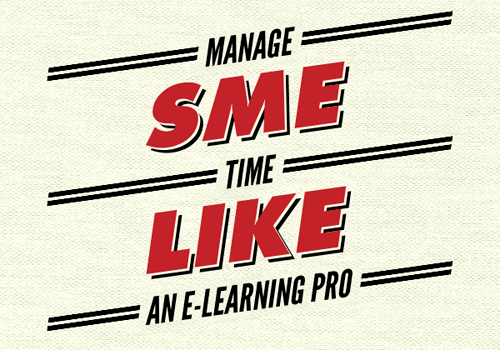Ready for the Nuts and Bolts? Managing Subject Matter Expert Time for a One-Hour E-Learning Course
In Part One of this series on Managing subject matter expert (SME) time, I talked about what a SME is, and the valuable role that SMEs play in training projects. I offered some tips for managing SME time, including the variables that affect SME time during design and development of your e-learning course, along with the importance of setting expectations.
Here in Part Two, I’ll walk through a typical one-hour e-learning course, and define the “what” and the “how much” of SME time, along with some best practices and tips for helping the process go smoothly.
Before we begin, I need to mention two important ingredients in the recipe for success.
First, clear and documented SME sign-off is essential at every stage. Sign-off helps you manage SME time by minimizing rework, which requires additional reviews.
Second, and I made this point in part one, but it’s worth restating: Respect is where it’s at when working with any team member, but especially with SMEs. They often have busy jobs elsewhere in the business and are not part of the learning and development team, so set expectations properly and be efficient. Invite their ideas and collaborate!
Subject Matter Expert Time in E-Learning: A Typical Breakdown
Let’s use a one-hour e-learning course as an example to illustrate how much SME time is needed within the e-learning development process. We can assume content is about two-thirds documented and stable. This is rather typical of many e-learning course upgrades.
Initial / Content Analysis Stage: 4-5 hours
This is primarily meeting time for project onboarding, kick-off meetings and data collection and analysis sessions with the SME and the ID.
Prior to working with a vendor like SweetRush, the SMEs have a bit of pre-work to do. The SMEs gather existing content and provide it to the client-side PM. Additionally, the client PM may need to provide some internal onboarding for the SMEs to help set the context and describe the nature of the vendor relationship.
Don’t forget that data analysis (virtual or live) is an iterative process. As data is collected from meetings between the SMEs and the ID, there will be emails back and forth with questions and clarifications.
Best practice tips:
- Set expectations with your SMEs that quick response to questions in the Initial stage is important. The ID will try to run with the content at hand to keep the process moving. However, the ID can only take it so far without SME guidance on pending areas.
- I suggest having the ID record the data analysis sessions. This cuts down on questions from the ID later, and allows for SMEs to tap into their own stream of consciousness, letting the best information come forth. This often leads to new examples and scenarios that keep the e-learning course engaging and relevant.
Detailed Design Stage: 2 hours
This is the time needed for SME review of the Detailed Design Document (DDD) - the map, plan or blueprint for the e-learning course. Think of it as the ten thousand foot view of what is being proposed for the e-learning. Well-crafted DDDs present content in an outlined or bulleted format so at a glance SMEs can see the overall solution. SME reviews of DDD’s should include:
- Learning objectives
- Content accuracy
- Overall completeness - is everything included that should be?
- Overall flow
- Suggested treatments - look, feel and functionality
The items in the list above are somewhat in order of importance from the SME’s perspective. The last two items on the list fall within the ID’s area of expertise. A DDD for a one-hour e-learning course can be 20-40 pages, but they are likely bulleted and can have a lot of whitespace.
Storyboard Phase: 3 hours
In this phase, the SME will review the e-learning storyboard. The five relevant points I listed above for SME reviews during the DDD apply to the SB phase as well. If the SME signed-off and did a thorough job on the DDD, the overall plan is locked in. What rises to the surface are the details. On a page-by-page basis, SMEs should be looking for…
- Are concepts clear and accurate?
- Do the examples used make sense?
- Does each concept/block of information included support one or more of the learning objectives?
- Is the e-learning course engaging in a way that supports the intended audience?
Best practice tips:
- Some of the actual functionality may be hard to envision if SMEs are new to the world of e-learning. In this case, the ID should do a web demo and discuss sample page types. Though the demos will not include specific content, the SME will begin to see how a page may look or function. Also, there may be a series of mockups or wireframes – rough sketches of custom pages/concepts within your course – for SMEs to view, and the demos will help the SME understand concepts they are not familiar with.
- A Storyboard for a one hour course can be 60-120 pages. Half of this information may be for the development team (engineering, illustrators, etc.), so it’s important to make sure SMEs know where they need to focus.
Alpha course review: 2 hours
If all the stages above are completed and on target, the review of the alpha course – the living breathing course you worked so hard to create - should go rather quickly. One hour courses can be anywhere from 40 to 80 screens in length.
Total Time: 11-12 hours
Does this amount of time align with your experience (acknowledging that the variables I described above do impact it)? I would love to hear your thoughts – leave a comment!
A few final thoughts: We get the best results when all team members – the vendor and the client – partner to create a concept, and leverage each other’s strengths. There may be many other players involved beyond our SMEs, IDs, and PMs: stakeholders, compliance reviewers, creative directors, engineers, illustrators, animators, etc. After years of experience and hundreds of courses, e-learning vendors like SweetRush know the process intimately, and how best to manage all the moving parts. It certainly takes a village and the result can be rather dynamic when you engage multiple parties bringing their best to the table. Like I said – a challenging job, and a highly rewarding one!
Get more e-learning and instructional design best practice tips from Catherine on her blog at SweetRush.com!







